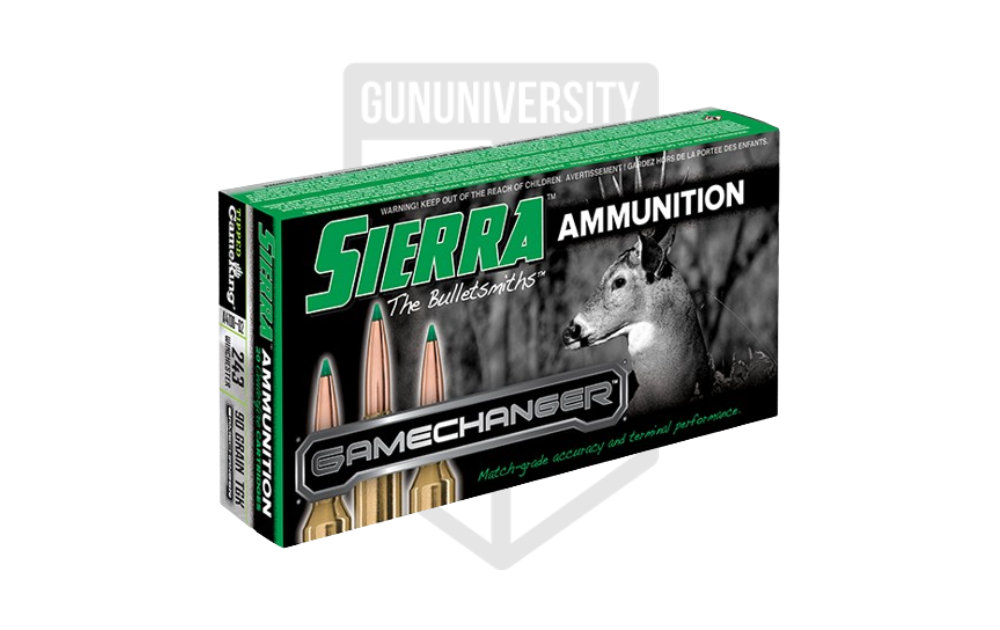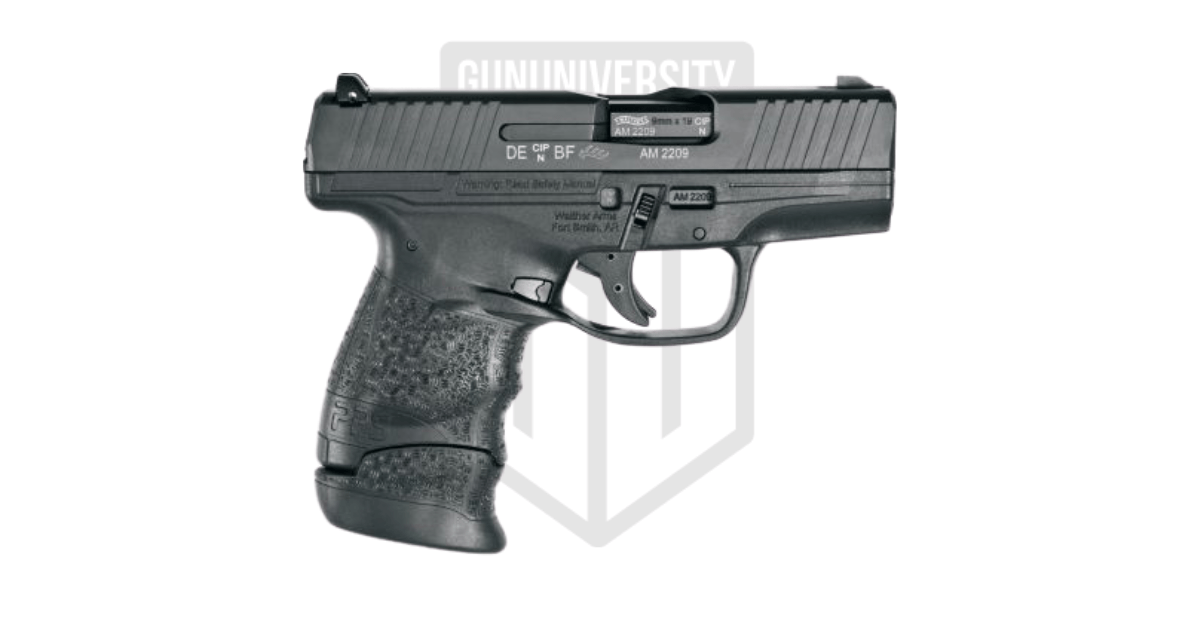6.5 Creedmoor vs 243 Winchester: Ammo Comparison
The 6.5 Creedmoor has a stellar reputation for long-range use thanks to its flat trajectory and significant range. The 243 Winchester also delivers a relatively flat trajectory, but it’s not as much of a long range star. Where the 6.5 Creedmoor versus 243 Winchester face-off really happens is among hunters, because hunting is an area where both cartridges shine. So which one’s better? We’re going to answer that question by comparing and contrasting the ballistic performances of the 6.5 Creedmoor and the 243 Winchester.
6.5 Creedmoor vs. 243 Winchester Specifications

6.5 Creedmoor
- Final Grade : A
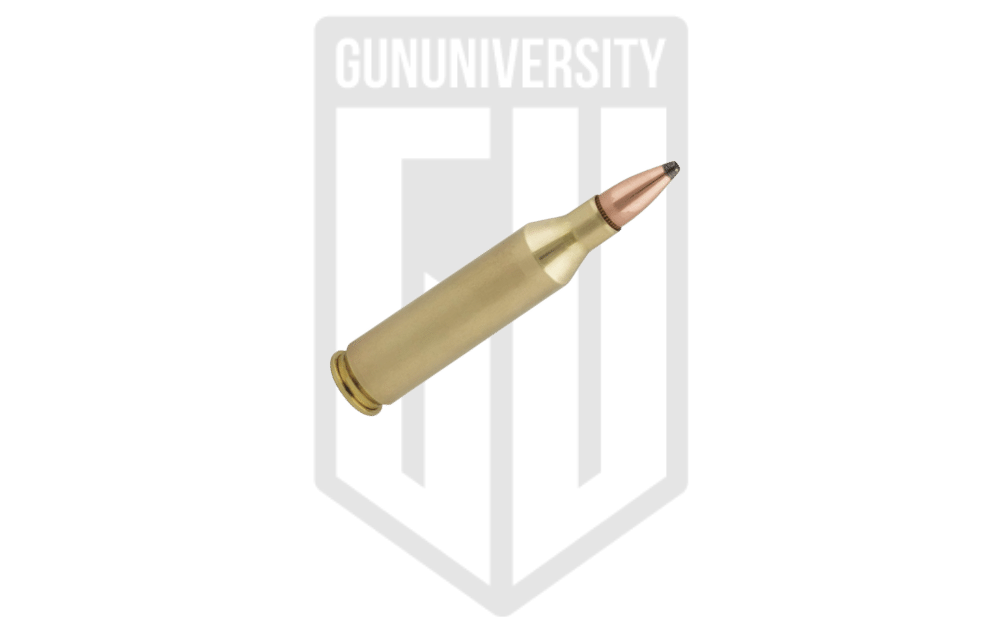
243 Winchester
Why compare 6.5 Creedmoor vs. 243 Winchester?
Hunters often compare 6.5 Creedmoor and 243 Winchester, especially those that require longer shots on animals like coyotes. They are also compared by some shooters who used 243 Winchester in the past for long-range shooting and see no need to change to 6.5 Creedmoor. Both cartridges are known for delivering good velocity without precipitous drop rates. Interestingly, the 6.5 Creedmoor is often credited with how it outperforms 308 Winchester. That just happens to be the 243 Winchester’s parent cartridge. Also, despite the 6.5 Creedmoor being clearly larger than the 243 Winchester, their maximum pressures are similar.
243 Winchester is considered outdated by many shooters while the 6.5 Creedmoor is frequently considered the current reigning champion of all things long range, including hunting. But that doesn’t mean there aren’t still a lot of dedicated 243 Winchester shooters, and they might have a point. After all, 243 Winchester has longevity and decades of proven performance in an incredibly wide range of environments to back it. Then again, 6.5 Creedmoor is trusted by a stunning number of experienced long-range shooters and hunters. Which is really the best?
It’s the cartridge vs. cartridge face-off: 6.5 Creedmoor vs. 243 Winchester.
6.5 Creedmoor Review
In the world of PRS (precision rifle series) shooting, 6.5 Creedmoor is king. It’s designed for a flat trajectory and fantastic effective range, and all without excessive felt recoil. The cartridge has carved out a place not only among precision shooters but hunters and sport shooters alike. It’s versatile, widely available, and continues to gain new fans as time goes by. But how was the 6.5 Creedmoor designed, and how does it really perform ballistically?
6.5 Creedmoor History and Purpose
6.5 Creedmoor was developed in 2007 by Dave Emary, the senior ballistic scientist at Hornady, and Dennis DeMille, vice-president of product development for Creedmoor Sports. It came about because DeMille wanted to create a factory cartridge for long-range shooting that performed well enough out of the box to meet national standards for competition.
The cartridge began as a wildcat and was, in fact, based on the 6mm XC used by David Tubb (who had a habit of winning NRA High Power National Championships with it). But the use of the 6mm XC required hand loading and there was no standardized set of loading data, which apparently lead to some confusion. It was DeMille who decided they should improve on that, and he went to Emary for help. Before they got started developing the load, DeMille let Emary know what his most important needs would be for the cartridge. Among other things, the new round would need to fit a certain magazine size while retaining the use of the 6mm bullets and deliver felt recoil less than the classic 308 Winchester. It also needed a high ballistic coefficient, deliver a flat trajectory, and not burn so hot that it wore out barrels too fast. There was more, but you get the idea.
When asked about the 6.5 Creedmoor, Emary said, “The original intent of the cartridge was an across-the-course match cartridge. We envisioned it as an off-the-shelf round that produced the accuracy and ballistics to compete in all match shooting disciplines right out of the box. At the same time, we realized that the same characteristics would make an exceptional hunting cartridge with the right bullets.”
The resulting cartridge was the 6.5 Creedmoor, and it does all those things and more. It’s been in production since 2008 and appears poised to become the new classic once it’s gained enough years of use to attain such status. In the meantime, it’s certainly popular, and for good reason.
Pros and Cons of 6.5 Creedmoor vs. 243 Winchester
- Max Pressure – 6.5 Creedmoor is loaded at a higher maximum pressure than 243 Winchester.
- Effective Range – The effective range of 6.5 Creedmoor while hunting is further than that of 243 Winchester.
- Bullet Weight – 6.5 Creedmoor utilizes heavier bullets.
- Drop Rate – The 6.5 Creedmoor has a drop rate that’s a bit faster than the 243 Winchester.
- Price – 6.5 Creedmoor is typically more expensive than 243 Winchester.
- Velocity – 6.5 Creedmoor velocities are lower than the 243 Winchester.
Best Ammo for 6.5 Creedmoor
The options 6.5 Creedmoor ammunition are extensive. Whatever you’re using it for, there’s probably a load out there to do it. These are our top task-specific picks for 6.5 Creedmoor:
Hunting Ammo
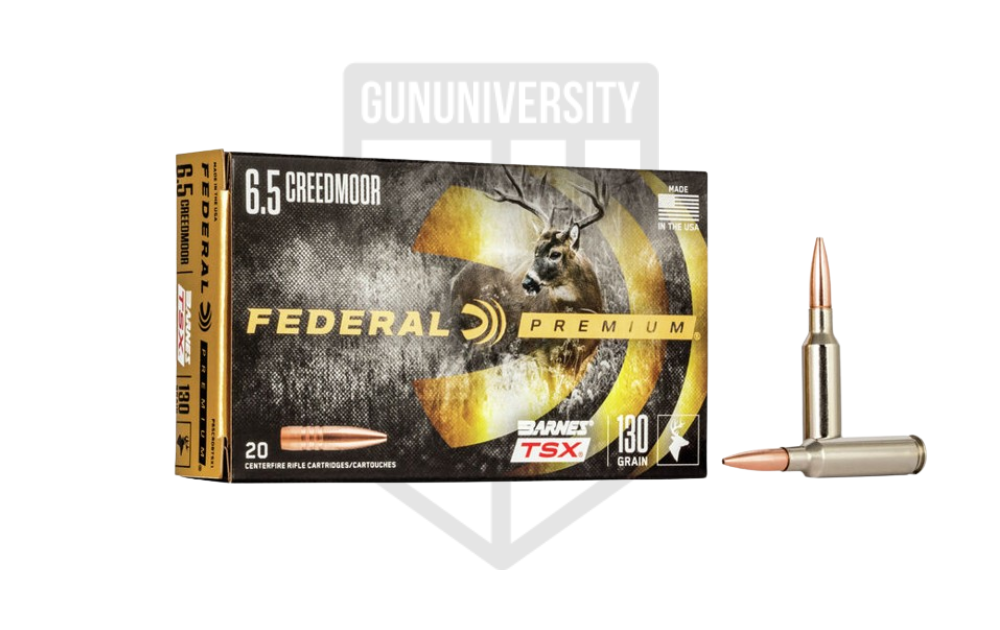
Federal Premium 6.5 Creedmoor 130 Gr Barnes TSX
Marketplace |
Cost Per Round |
| Gun Deals | $1.85 |
| Sportsman’s Guide | $2.44 |
| Guns.com | $2.44 |
Match grade/versatile use
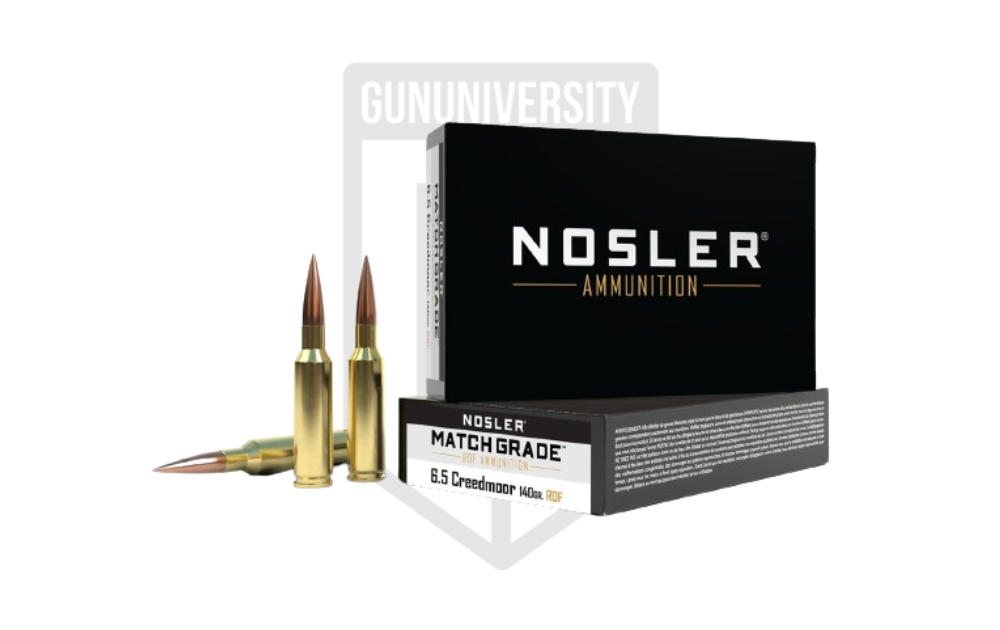
Nosler Match Grade 6.5 Creedmoor 140 Gr RDF
Marketplace |
Cost Per Round |
| Gun Deals | $1.84 |
| Firearms Depot | $2.11 |
| Guns.com | $2.39 |
Practice Ammo
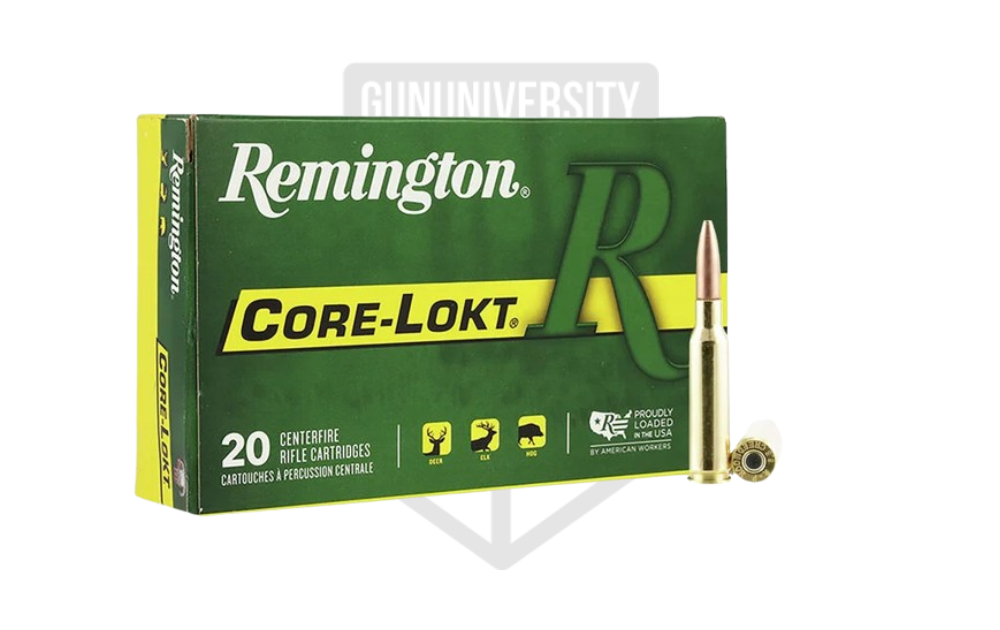
Remington Core Lokt 6.5 Creedmoor 140 Gr Core Lokt Soft Point
Marketplace |
Cost Per Round |
| Gun Deals | $1.24 |
| Guns.com | $1.49 |
| Sportsman’s Guide | $1.54 |
243 Winchester Review
The 243 Winchester is a great cartridge that’s favored by many hunters, varmint hunters in particular. It also sees a fair amount of use among long-range shooters, although it isn’t as commonly used as others. With almost three-quarters of a century of production behind it, the 243 Winchester has more than earned its spot as a trusted cartridge capable of fantastic velocity and accuracy. Let’s take a look at its history and development.
243 Winchester History and Purpose
Design of the 243 Winchester began in 1952. The purpose was to create a top-performing hunting round, and it certainly seems to have been a success. The development process was started by Warren Page, who was at that time the editor of Field & Stream magazine. Page’s wildcat round performed well, and of course, he did some writing about it. He named it the 240 Page Super Pouper and had fantastic hunting success. At about the same time, RCBS founder Fred Huntington developed the 243 Rockchucker. It took awhile for a major manufacturer to step in, but eventually Winchester got involved and fine-tuned the cartridges to create a standardized load. 243 Winchester officially hit the market in 1955.
The first rifle to be produced chambered in 243 Winchester was the Winchester Model 70, a bolt-action rifle. It was released with the Winchester Model 88, also in 243 Winchester, which was a lever-action. It didn’t take long for other manufacturers to release firearms chambered in the latest and greatest cartridge and before long, the 243 Winchester had a dedicated following. That fan base remains today. As technology has advanced, 243 Winchester has benefited, and it’s still a top-performing cartridge with a lot of uses. But does it outdo 6.5 Creedmoor?
Pros and Cons of 243 Winchester vs 6.5 Creedmoor
- Velocity – The 243 Winchester produces higher velocities than 6.5 Creedmoor.
- Drop Rate – 243 Winchester has a slower drop rate than 6.5 Creedmoor.
- Price – 243 Winchester is usually more affordably priced than 6.5 Creedmoor.
- Bullet weight – The 243 Winchester uses a smaller bullet meaning smaller wound cavities when hunting.
- Energy – 243 Winchester produces less energy on target than 6.5 Creedmoor does.
- Wind Drift – 243 Winchester has less resistance to wind drift than 6.5 Creedmoor.
Best Ammo for 243 Winchester
Here are some of our favorite ammo choices for 243 Winchester:
Match Ammo

Nosler E-Tip 243 Winchester 90 Gr Polymer Tipped
Marketplace |
Cost Per Round |
| Gun Deals | $2.02 |
| Firearms Depot | $2.32 |
| Guns.com | $2.44 |
Practice Ammo
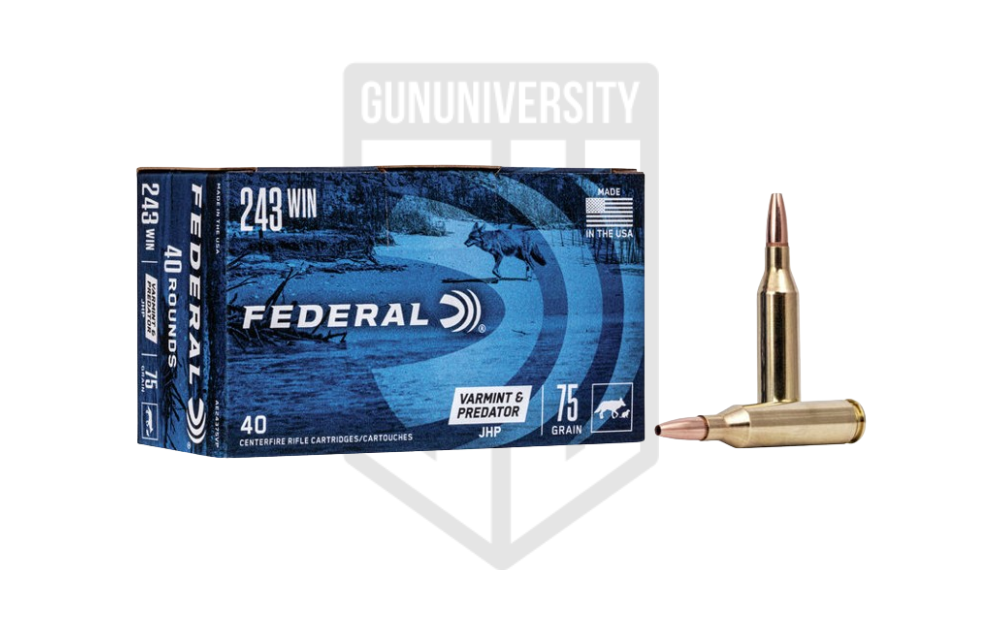
Federal American Eagle 243 Winchester 75 Gr Hollow Point
Marketplace |
Cost Per Round |
| Gun Deals | $0.97 |
| Gritr Sports | $1.22 |
| Guns.com | $1.32 |
Ballistics Comparison: 6.5 Creedmoor vs. 243 Winchester
A good question about 6.5 Creedmoor vs. 243 Winchester is whether they’re evenly matched from a ballistic standpoint. We know that 6.5 Creedmoor is loaded with heavier bullets than 243 Winchester, and we know 243 Winchester produces higher velocities than 6.5 Creedmoor. But what does that translate to for ballistics? Which cartridge has a flatter trajectory? Which one delivers more energy at longer ranges?
To compare cartridges beyond 100 yards, we’re going to take a look at a few different loads. First, let’s consider Nosler Match Grade 6.5 Creedmoor 140 grain RDF with a ballistic coefficient of 0.658 against Nosler E-Tip 243 Winchester 90 grain Polymer Tipped with a ballistic coefficient of 0.403.
| Distance (yards) | Nosler Match Grade 6.5 Creedmoor 140 grain RDF Velocity (fps) | Nosler Match Grade 6.5 Creedmoor 140 grain RDF Energy (ft-lbs) | Nosler E-Tip 243 Winchester 90 grain Polymer Tipped Velocity (fps) | Nosler E-Tip 243 Winchester 90 grain Polymer Tipped Energy (ft-lbs) |
|---|---|---|---|---|
| 0 | 2650 | 2183 | 3050 | 1859 |
| 100 | 2518 | 1970 | 2809 | 1576 |
| 200 | 2384 | 1767 | 2580 | 1330 |
| 300 | 2255 | 1581 | 2362 | 1115 |
| 400 | 2131 | 1411 | 2155 | 928 |
| 500 | 2010 | 1256 | 1959 | 767 |

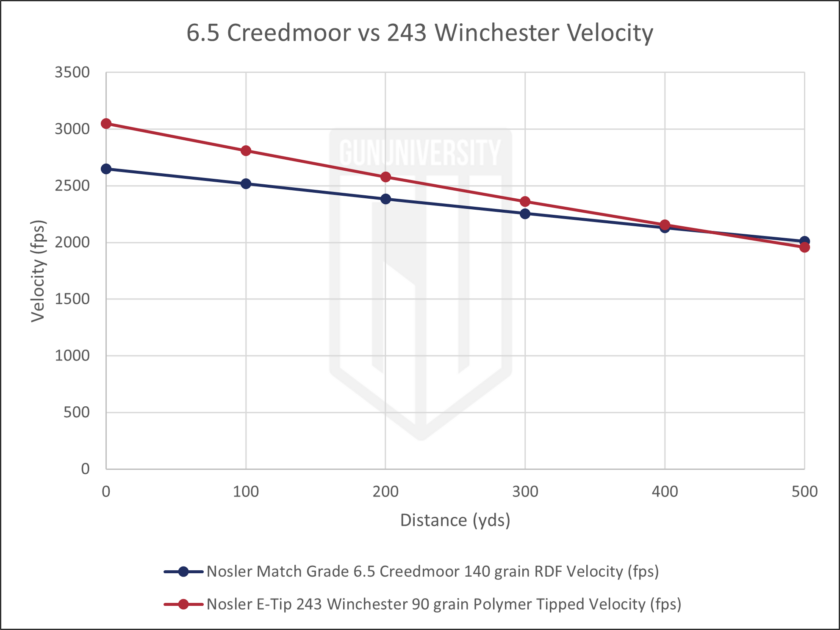
As you can see in the ballistic table above, the 243 Winchester produces higher velocity not only from the muzzle but to 400 yards. At 500 yards, it’s only slightly less velocity than the 6.5 Creedmoor. On the energy side, the 6.5 Creedmoor produces more right from the muzzle and continues to produce more energy to 500 yards—and by 500 yards the difference is extreme. Using this chart as a comparison, the two cartridges appear rather evenly matched for velocity with 6.5 Creedmoor producing a lot more energy.
If we change over to target loads and compare Remington Core Lokt 6.5 Creedmoor 140 grain Core Lokt Soft Point with a ballistic coefficient of 0.410 and Federal American Eagle 243 Winchester 75 grain Hollow Point with a ballistic coefficient of 0.234? Does it stay the same, or do the results look different?
| Distance (yards) | Remington Core Lokt 6.5 Creedmoor 140 grain Core Lokt Soft Point Velocity (fps) | Remington Core Lokt 6.5 Creedmoor 140 grain Core Lokt Soft Point Energy (ft-lbs) | Federal American Eagle 243 Winchester 75 grain Hollow Point Velocity (fps) | Federal American Eagle 243 Winchester 75 grain Hollow Point Energy (ft-lbs) |
|---|---|---|---|---|
| 0 | 2700 | 2266 | 3375 | 1897 |
| 100 | 2484 | 1918 | 2943 | 1443 |
| 200 | 2278 | 1613 | 2551 | 1084 |
| 300 | 2082 | 1347 | 2191 | 800 |
| 400 | 1895 | 1116 | 1861 | 577 |
| 500 | 1721 | 921 | 1569 | 410 |
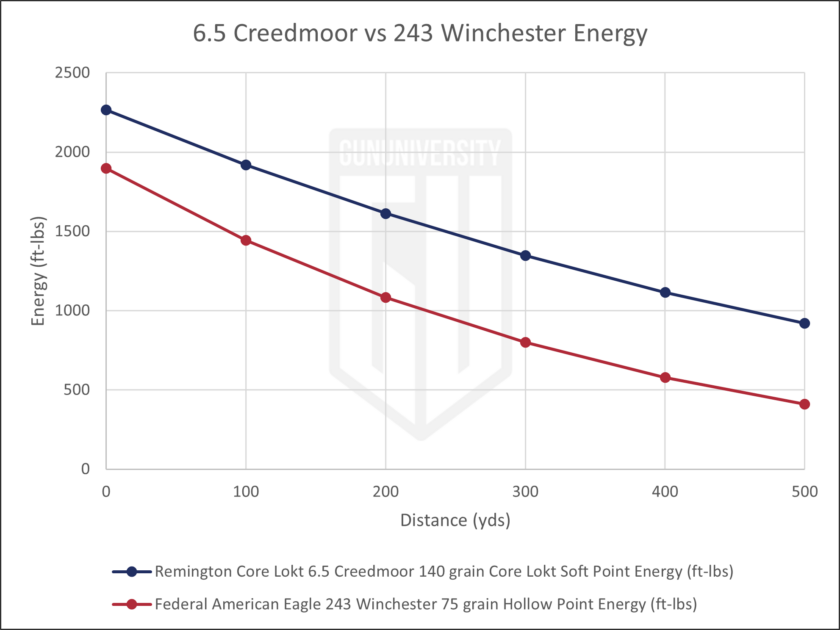

In this chart we see a more drastic difference in muzzle velocity, with 243 Winchester producing a lot more. This shifts around 300 yards, and by 500 yards, the 6.5 Creedmoor’s velocity is higher. As for energy, although 243 Winchester starts out strong, the 6.5 Creedmoor delivers greater energy throughout. Let’s consider trajectory for the same two loads:
| Distance (yards) | Remington Core Lokt 6.5 Creedmoor 140 grain Core Lokt Soft Point Drop (inches) | Remington Core Lokt 6.5 Creedmoor 140 grain Core Lokt Soft Point Wind Drift (inches) | Federal American Eagle 243 Winchester 75 grain Hollow Point Drop (inches) | Federal American Eagle 243 Winchester 75 grain Hollow Point Wind Drift (inches) |
|---|---|---|---|---|
| 50 | 0.9 | 0.0 (muzzle) | 0.3 | 0.0 (muzzle) |
| 100 | 2.1 | 0.8 | 1.3 | 1.1 |
| 200 | 0.0 | 3.4 | 0.0 | 4.8 |
| 300 | -8.8 | 8.2 | -6.7 | 11.5 |
| 400 | -25.5 | 15.0 | -20.6 | 21.9 |
| 500 | -52.2 | 24.9 | -45.1 | 37.3 |
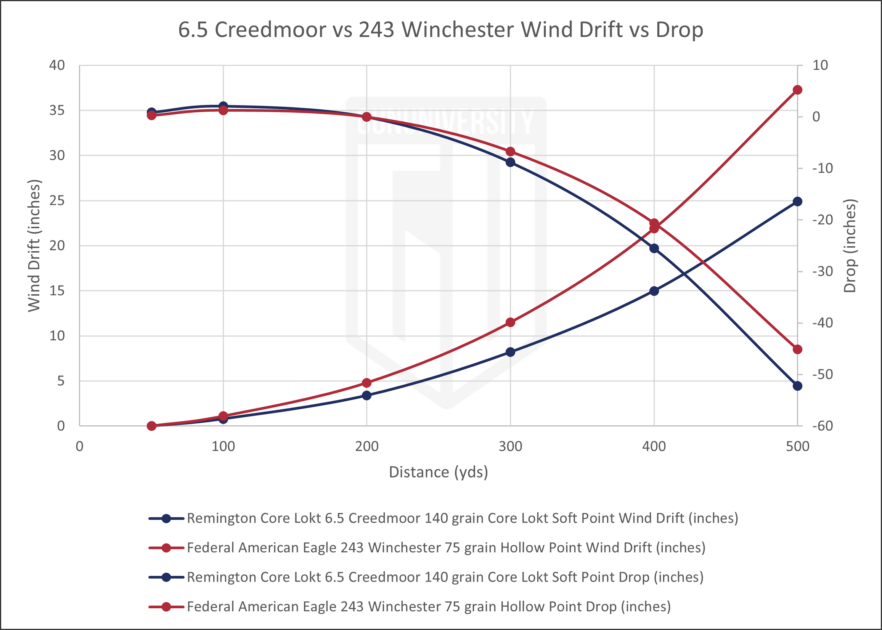
Here, we can see that the drop rate of the 243 Winchester is somewhat less than that of the 6.5 Creedmoor, although the difference isn’t really extreme. As for wind drift, the lighter bullet of the 243 Winchester makes it more susceptible, and it drifts more quickly than the heavier 6.5 Creedmoor.
Based on this chart, it looks like you get less drop with 243 Winchester, but drift is greater with it, too. So, which is better? 6.5 Creedmoor or 243 Winchester?
Our Take – 6.5 Creedmoor vs. 243 Winchester
If we’re choosing an overall ballistic winner, it’s the 6.5 Creedmoor. It pushes heavier bullets at fantastic velocities with great energy and maintains a flat trajectory. The 6.5 Creedmoor is a good round and the logical choice for long-range shooting. It also maintains an edge for hunting game—especially larger game—because that higher energy level is important for hunters. Of course, there are some situations where the 243 Winchester might be preferable. For example, if you’re a varmint hunter and want a lighter, slightly faster option, the 243 Winchester offers that. Rifles in 243 Winchester are also generally more affordably priced than those chambered in 6.5 Creedmoor, and the ammo can also be more budget-friendly.
There are situations where the differences between the two cartridges are less important than others. Maybe you’re fine running a gun with lighter bullets and more tendency to drift. Or you might prefer 243 Winchester because you need those smaller bullets while you’re hunting furbearers (and you know 6.5 Creedmoor will cause more damage). There are specific uses for various cartridges and that remains true with these two.
Which is your favorite? 6.5 Creedmoor or 243 Winchester? Tell us why in the comments.
Recent Posts
December 20, 2025
December 15, 2025
December 15, 2025
December 12, 2025

